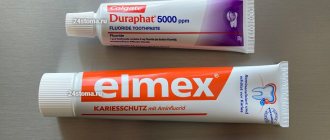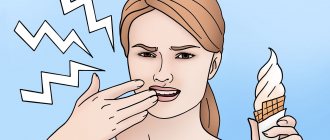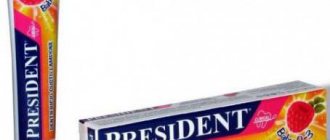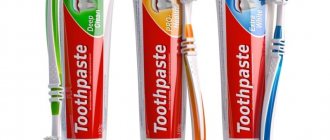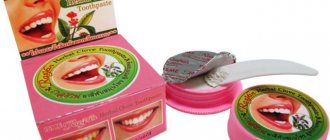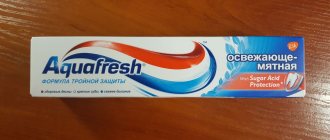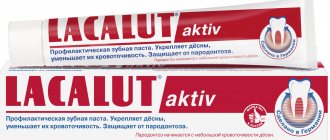Author of the article:
Soldatova Lyudmila Nikolaevna
Candidate of Medical Sciences, Professor of the Department of Clinical Dentistry of the St. Petersburg Medical and Social Institute, Chief Physician of the Alfa-Dent Dental Clinic, St. Petersburg
For many years, every second person in the street was convinced that a good toothpaste must certainly contain fluoride. Our grandparents stubbornly insisted on the importance of this element. But is fluoride really necessary in toothpaste, or does the harm of this microelement still outweigh its benefits? Let's try to figure it out.
What role does fluoride play in our body?
When answering the question of what fluorine is and why it is needed, it should immediately be explained that in its pure form this element is a rather poisonous and toxic gas. However, in products and hygiene products this substance is contained in the form of salts - sodium or calcium fluoride. In this form, it can bring tangible benefits to the body.
Our need for this element is no more than three milligrams per day.
So, what does fluoride do in toothpaste and why is it needed? First of all, it supports the natural mineralization of bone tissue, making it strong and at the same time elastic. Sufficient intake of this substance into the body promotes the growth of nails and hair, strengthening of dental tissues. In addition, it provides additional protection for the body from the effects of pathogenic microflora, improves immunity, and helps eliminate toxins and heavy metals.
Chemical substance, biochemical processes
In addition to water, natural sources of fluoride are fish, apples, and tea. fluorine acts as an inhibitor in many foods, affects the metabolism of fats and carbohydrates, and is involved in the formation of teeth and bones. But at the same time, we must not forget that the same fluorine is a chemical substance of the second hazard class. Fluoros in Greek means destroyer. Fluorine gas F2 is lethal to humans. No other element has a physiologically required amount so close to the dose that produces a toxic effect. Under the influence of excess fluoride in the body, an imbalance of phosphorus-calcium metabolism occurs, which leads to disturbances in the mineralization of bone tissue and ligaments.
Colloid degeneration of thyroid tissue
Scientists - fluorine causes colloidal degeneration of thyroid tissue, reduces immunity, inhibits intracellular synthesis processes and accelerates physiological aging. According to a study published in the journal Behavioral Brain Research, fluoride can cause changes in brain tissue similar to Alzheimer's disease and some other forms of dementia. And to continue this sad list... have you ever seen warning notices hanging in pharmacies or stores selling fluoride-containing toothpaste?
If fluoride can really help our teeth, then only in microdoses. It is desirable that this element enters our body exactly in the quantity in which we are able to absorb fish, apples, tea and mineral water.
Fluoride toothpaste? By the way, about water. Even if you prefer tap water to mineral water, do not think that you can safely use fluoride toothpastes. In the sixties, many other countries followed America's example; the side effects of water fluoridation were discovered; most of these countries abandoned such experiments on their citizens. In Germany, fluoridation of water is expressly prohibited, since it is the same as prescribing the same medicine to everyone and forcing them to take it, regardless of the possible consequences. We can say that water is now fluoridated only in America and Ireland. But even there there are fighters against forced fluoridation of the population.
Dentists simply do not know how dangerous water fluoridation is. They do not know that the fluoride used for this is obtained from toxic waste containing lead and arsenic. Mac Auley claims that the truth is being hidden from the Irish; there has never been any research done into the effects of drinking fluoridated water. As for Russia, we have both territories with a naturally low fluorine content in water, and regions where the amount of fluorine exceeds the norm; water fluoridation is considered a benefit, as a promising direction of development, and this technology is being implemented everywhere. At least in those regions where there is money for this.
Why is this component so important for dental health - the benefits of the substance
The content of this element in oral care products protects against caries, makes enamel stronger, effectively removes plaque and fights pathogenic microflora. Let's take a closer look at the undoubted advantages of this component.
Prevention of caries
The enamel is constantly exposed to aggressive acids that are released with saliva. Food remains and other external factors lead to the formation of plaque, which gradually transforms into hard dental deposits, leading to the destruction of the enamel layer. As a result, a white spot first appears, which darkens and turns into a carious cavity.
The photo shows caries at the spot stage
Fluorine penetrates the crystal lattice of enamel, strengthens it and increases resistance to pathogenic microorganisms. It provides prevention of caries and prevents its further development, even if the disease is already at the white spot stage.
Decalcification protection
The substance promotes a process called “remyelination” - the transition of ions from the blood to the body’s tissues. Saliva, which is produced during food intake, leads to the opposite effect, that is, loss of calcium from dental tissues. When calcium and fluoride ions enter the oral cavity, they penetrate the crystal lattice of the enamel, strengthening it and preventing the destruction of hard tissues under the influence of saliva.
Strengthening enamel
The basis of enamel is calcium hydroxyapatite. By interacting with the microelement in question, this salt is converted into a new substance - fluorine hydroxyapatite. Thus, the microelement in question acts as a calcium protector, protecting it from the aggressive effects of acids in the oral cavity.
Prevention of the growth of pathogenic microflora
Pathogenic microorganisms that form plaque secrete special enzymes necessary for the breakdown of carbohydrates and their absorption. Our substance blocks the production of these enzymes, which prevents the further spread of pathogenic microflora.
Fluoride works great against plaque
“I have been using fluoride toothpaste for a year now and am very pleased with the results! About six months ago I bought myself an irrigator, so with them, every morning cleaning feels like after professional hygiene at the dentist. I recently had a preventive examination and there were no problems with the enamel. And I myself understand that sensitivity has not appeared, the teeth are white, without spots or irregularities. It seems to me personally that all this hysteria about the harm of such products is greatly exaggerated!”
AlesyaK., Moscow, from correspondence on the woman.ru forum
Stopping the secretion of lactic acid
This microelement blocks excess lactic acid synthesis, thereby effectively suppressing the growth of pathogenic microflora. This acid is produced by microorganisms during their life and reproduction. Products containing this component prevent this process, thereby providing additional protection for the enamel.
Sources
- https://www.health.harvard.edu/blog/are-antibacterial-products-with-triclosan-fueling-bacterial-resistance-2019080617473
- Weatherly LM, Gosse JA Triclosan exposure, transformation, and human health effects // J. Toxicol Environ Health B Crit Rev. 2017; 20(8): 447–469. doi: 10.1080/10937404.2017.1399306
- What is triclosan? // Medvyvod.ru. 2014. February 15. URL: https://www.medvyvod.ru/medical_news/3098.html
- Detusheva E.V. Modeling a biofilm in bacteria on a solid nutrient medium and studying the patterns of formation and resistance to triclosan: dissertation. ...cand. biol. Sci. Obolensk, 2016. 158 p.
- Campbell L., Zirwas MJ Triclosan. // Dermatitis. 2006. Vol. 17(4). P. 204-207.
- Shaofang Cai, Jiahao Zhu, Lingling Sun, et al. Association between urinary triclosan with bone mass density and osteoporosis in US adult women, 2005-2010 // J Clin Endocrinol Metab. 2019; 104(10): 4531–4538
- Dhillon GS, Kaur S, Pulicharla R, Brar SK, Cledón M, Verma M, Surampalli RY. Triclosan: current status, occurrence, environmental risks and bioaccumulation potential // Int J Environ Res Public Health. 2015. May 22; 12(5): 5657–5584
- Vosátka R, Krátký M, Vinšová J. Triclosan and its derivatives as antimycobacterial active agents // Eur J Pharm Sci. 2022. Mar 1; Vol. 114. P. 318–331
- Chigrinets S.V., Bryukhin G.V. The impact of endocrine disruptors on the quality of ejaculate in men // Andrology and genital surgery. – 2022. – T. 19. – P. 42–47
- https://www.fda.gov/consumers/consumer-updates/5-things-know-about-triclosan
- The Svoboda factory has resumed production of soap with triclosan // Cosmetic-industry.com. 2022. April 3. URL: https://cosmetic-industry.com/fabrika-svoboda-vypustit-polmilliona-shtuk-myla-s-triklozanom-do-kontsa-mesyatsa.html
What types of pastes with fluoride compounds are there?
Products that contain this component are usually classified as therapeutic and prophylactic. If the concentration is insignificant, then the product will be considered hygienic. Different salts of this component can be presented in different forms: amino fluorides, sodium fluorides, sodium monofluorophosphates and others. Pastes with a high content of the substance are recommended for use in courses.
Such pastes are usually therapeutic and prophylactic
As for the question of which toothpaste does not contain fluoride, the range of possible alternatives is less diverse. Products that do not contain fluoride usually contain other active ingredients, which are also characterized by their own advantages and disadvantages.
Purpose and features of triclosan
The component was first obtained in 1965 by Swiss scientists. The drug belongs to the chlorophenolic group. It is widely used in hygiene products and household chemicals as an antibacterial substance. After the introduction of this component, many studies were conducted to study its safety in relation to human health.
Due to its antibacterial properties, triclosan is active against a wide range of microorganisms. The effectiveness of its use is confirmed by many years of practical experience in using it in hygiene products. The component interacts well with other components of dental products, which makes it possible to create complex formulations. Even in low concentrations it does not lose its properties.
Triclosan acts on the cytoplasmic membranes of various microorganisms, thereby effectively neutralizing pathogenic fungi and bacteria. A significant disadvantage is the destruction of not only negative, but also beneficial microflora.
Can it be used by children?
When choosing a product for children's teeth, it is important to assess the possible risks - whether it will bring more benefit or harm in your particular case. And to do this, you should first show your child to the dentist and consult with him about purchasing the most suitable toothpaste.
You should also take into account that most young children swallow part of the paste during brushing, and this can cause undesirable consequences, including stomach and intestinal upset. So, the concentration of the component should not exceed 1500 ppm1 - this is how this indicator will be indicated on the packaging, indicating how much of the substance is contained in this paste.
For a child, you need to choose only children's toothpaste
However, modern manufacturers also produce fairly effective and safe fluoride products for children, which provide excellent prevention of childhood caries. But it can only be used in courses and according to the indications of a pediatric dentist.
What harm could it do?
Fluoride is found not only in hygiene products, but also in food and even tap water. The acceptable daily intake is approximately 3 mg. But in certain regions and localities, the content of the substance in running water greatly exceeds the norm, which can lead to an overdose of this microelement, especially in children.
So, why is it considered that such pastes are harmful, and why is an excess of this substance dangerous? Let's start with the fact that the element in question is characterized by toxicity and the ability to accumulate in tissues, including tooth enamel - this is one of the reasons why such products cannot be used constantly.
When this happens, a pathology called fluorosis develops. White spots appear on the teeth, after which they become noticeably darker, literally corroding hard tissue. This condition requires treatment by a dentist. In such cases, specialists usually prescribe remineralization and fluoridation, as well as the use of special hygiene products that help restore damaged tissue.
An excess of the substance in the body can cause fluorosis
FDA Regulation of Triclosan
In 2013, the FDA (USA) asked antibacterial soap manufacturers to prove that their products are more effective than regular soap in preventing disease, or to withdraw them from the market [1, 2]. Because no such evidence was provided, the FDA in September 2016 banned the sale of antiseptic hand and body cleansers containing a number of ingredients, including triclosan. The basis for the ban was the belief that such antiseptic products do not provide the consumer with additional protection compared to conventional cleaning products and may cause harm in the long term. The ban applies to liquid soap, gels, foam, and bar soap. It does not apply to “sanitary gels,” wet wipes, or specialty antiseptics. Triclosan (TCS) is still allowed to be used in toothpaste, hand sanitizer and mouthwash.
The FDA announced that the final decision to ban triclosan will take effect in April 2022 [1].
The European Union has banned the use of triclosan in all biocidal hygiene products starting January 2022 [2].
The negative effect of triclosan is due to its ability to destroy both harmful (harmful) and beneficial bacteria for humans. Long-term use leads to a weakening of the body's immune forces, and resistance to antibiotics develops. It is believed that with prolonged use of products containing triclosan, it accumulates in the body, which leads to the occurrence of a number of diseases.
Substance poisoning - symptoms
A sufficient, but not excessive intake of this substance into the body helps strengthen the enamel and improve the condition of the teeth. However, overdose can cause serious damage. Usually in such cases they talk about the development of fluorosis. Among the most common varieties of this pathology, experts in the field of dentistry distinguish spotted, streaked, chalky-speckled, erosive and destructive forms. Let's look at them in a little more detail:
- spotted - involves the formation of small light spots on the enamel, which can merge with each other, forming one large spot,
- streaked - light stripes of different shapes appear on the incisors, which can also combine to form fairly large strokes,
- chalky-mottled - the surface of the teeth becomes dull and yellowish, while many dots and specks appear on its surface. Pathological abrasion of the enamel is noted, due to which the dark color of dentin begins to appear,
- erosive – leads to the formation of numerous specks, but primarily affects the chewing surface of the teeth,
- destructive – dental tissues become fragile and quickly break down.
The photo shows dental fluorosis.
An excess of fluoride in the body also affects the condition of the skeletal system. One possible complication is osteoporosis, in which the bones become soft and calcium is quickly washed out of them. Pathological changes occur in the joints, causing ankylosis to develop. In advanced cases, the liver and kidneys suffer.
How to remove excess substance from the body
There are methods that allow you to remove excess fluoride from the body, but they give the desired result only if the pathology is in the initial stages of its development. Here are the main ways to combat intoxication with this element:
- iodine – promotes the excretion of the substance in the urine, so it is recommended to increase the consumption of foods rich in this component: strawberries, lingonberries, beans, potatoes,
- boron – also effectively removes fluoride and is found in high concentrations in honey, nuts, dates, avocados, prunes,
- selenium – blocks the activity of an excess element, found in sufficient quantities in Brazil nuts,
- dry sauna – helps remove accumulated toxic substances through sweating.
Consumption of iodine-containing products helps remove the substance from the body.
But before moving on to measures to remove the substance, it is necessary to limit its entry into the body. For a while, you will have to give up foods with a high content of it, switch to clean bottled water, and stop using fluoride-containing hygiene products.
HOW TO PROTECT YOUR BODY FROM THE EXPOSURE OF FLUORIDE WHEN BRUSHING YOUR TEETH
To ensure that active fluoride ions do not cause harm to the body, you must adhere to a few simple rules:
- Study the packaging of the toothpaste when purchasing, pay attention to which fluoride compound is included in its composition and in what concentration.
- Before using a fluoridated product, you should consult with a specialist ; perhaps the level of fluoride in the water in the region where you live is sufficient and such a paste will only cause harm.
- Children under 6 years of age should not use fluoridated toothpaste . At this age, children do not fully have the skills to brush their teeth, which can cause them to swallow large amounts of hygiene products.
- When planning a vacation in other regions, you should pay attention to the level of natural fluoride content in drinking water. If the content is normal or high, you should stop using fluoridated toothpastes during the rest period.
- To minimize the amount of fluoride that enters the body when brushing your teeth, the amount of toothpaste should not exceed the size of a small pea.
In addition to pastes, fluoride is included in rinses, special gels and chewing strips, as well as dental preparations that are used in a professional office. Therefore, the choice of a method for preventing the development of caries should be left to the dentist and strictly adhere to all his recommendations.
Source
Tips for choosing dental hygiene products
In order for daily cleaning to be as effective as possible, you need to carefully consider the choice of toothpaste. It is best to consult your dentist in this matter and give preference to the product that is most suitable for your specific case. All toothpastes on the market can be divided into three independent categories:
- hygienic – used for daily cleansing of enamel and aromatization of breath,
- medicinal – they contain active additives that, when interacting with damaged or inflamed tissues of the oral cavity, help stop pathological processes,
- therapeutic and prophylactic - also contain active components, but in lower concentrations, prevent the development of many dental diseases - teeth and periodontal tissues.
When choosing a toothpaste, carefully study its composition. You need to
choose which toothpastes contain fluoride, or give preference to a product without this component, taking into account the current condition of the teeth and oral cavity. The dentist will help you with this after examining and assessing the current condition of the enamel.
Properties of toothpastes
When choosing a paste, it is important to pay attention to its abrasiveness, composition, consistency and taste. A properly selected paste will not only bring benefits, but will also make the cleaning process more enjoyable.
The abrasiveness of the toothpaste determines the intensity of the impact on the enamel. The degree of abrasiveness depends not only on the number of abrasive particles, but also on their size. The larger they are, the more they polish the enamel. The number and size of particles form the abrasiveness index, which is indicated on the paste packaging by the abbreviation RDA.
Types of RDA:
- RDA 0 - for children under 2 years old.
- No more than RDA 20 - for children from 2 years old.
- RDA from 20 to 50 - for sensitive teeth and gums.
- RDA from 50 to 80 - for normal teeth.
- RDA from 80 to 110 - for polishing enamel if you need a slight brightening effect (they should not be used daily).
- Above RDA 110 - for intense brightening effects (not recommended for chips and cracks of enamel, as well as for increased tooth sensitivity).
Due to the fact that children's enamel is even more sensitive than adult enamel (the surface of a child's tooth is much softer and contains fewer minerals), the composition of a child's toothpaste should contain abrasive substances to a minimum. Among them are soda and titanium dioxide. Such elements can activate sensitivity and damage dental tissue in children.
When choosing a paste, pay attention not only to its purpose, smell or taste, but also to its composition!
Rating of the best products containing fluoride
Today on pharmacy shelves you can find a wide variety of different brands of dental and oral hygiene products. Let's take a closer look at which pastes contain this substance and are considered the most popular in their segment.
Paradontax for healthy teeth and gums
According to the manufacturer, the paste helps restore gums and reduce signs of inflammation and bleeding. The presence of fluoride in its composition ensures high-quality plaque removal and caries prevention. According to reviews, within just a few days of using Paradontax, gums acquire a healthy pink tint, and teeth become noticeably whiter.
Colgate for caries protection
One of the most popular companies today that produces various hygiene products to keep the oral cavity clean and healthy. Fluoride paste helps prevent the development of caries in the initial stages, effectively remove plaque and prevent stone formation.
Blend-a-med with active fluorine in its composition
This option is optimal in terms of price and quality ratio. The product is affordable and quite effective - it successfully removes plaque, eliminates unpleasant odor, and prevents gum inflammation. You need to understand that using a paste for daily use is unlikely to achieve a perfectly snow-white smile, but it will definitely help with plaque and bacteria.
Sensodyne against hypersensitivity
This remedy effectively combats hyperesthesia - increased sensitivity of enamel, especially during temperature changes and mechanical irritation. In addition, it perfectly fights the first signs of caries. Before you start using any product that contains high fluoride, it is best to talk to your dentist. Constant use of such pastes is undesirable.
How to brush your teeth correctly
Choosing the right toothpaste is only half the battle. To achieve a visible and tangible effect, it is important to learn how to properly carry out daily cleaning. Let us remind you that the main rule of maintaining oral hygiene is regular cleaning of the enamel with a brush and paste. As for the technique of its implementation, experts in the field of dentistry provide several more important recommendations in this regard:
- from the outside, the teeth must be cleaned with vertical sweeping movements, starting from the gums (if you brush in a horizontal direction, you can damage the enamel),
- similar vertical movements should be used to clean the inner surface,
- posterior molars can be cleaned using horizontal movements, paying special attention to the chewing surface,
- Next, you should move on to the tongue - its surface must be cleaned, since it is on it that the largest number of bacteria accumulate.
It is better to learn the correct cleaning technique from childhood. This is one of the reasons why, after the appearance of the child’s first teeth, it is imperative to show him to the dentist for preventive care. Even if you are not sure as an adult that you brush your teeth correctly, a professional dentist will definitely help you with this.
Choosing a brush - expert advice
Another mandatory attribute of daily oral care is a brush. Her choice also needs to be taken seriously, and dentists give the following advice on this matter:
- the head should not exceed 3 cm in length,
- it is better to choose models with artificial bristles, since natural ones create favorable conditions for the growth of bacteria,
- The ribbed back surface of the head is designed to clean the tongue - there is no need to additionally purchase a special scraper.
It is important to choose the right toothbrush.
If you have sensitive gums that are prone to inflammation and bleeding, it is better to give preference to a brush with soft bristles. But keep in mind that it will be worse at cleaning the enamel from plaque, so the procedure must be especially intense. Hard brushes are intended to be used according to indications - otherwise they can injure the gums and enamel and do more harm than good.
Additional oral care tips
Even with systematic brushing of teeth twice a day and regular rinsing after meals, any dental problems cannot be completely ruled out. To further protect yourself from caries and other troubles, it is better to limit the consumption of sweets and carbonated drinks, coffee and smoking - all of these are the main provocateurs of pathological processes in the oral cavity.
Try to give up bad habits
You must remember to use fossa threads, and also visit the dentist’s office regularly - at least twice a year. If you notice suspicious symptoms, you should immediately consult a doctor - this is the only way to detect any problem in its very beginnings, and therefore quickly resolve it.
- According to WHO.
